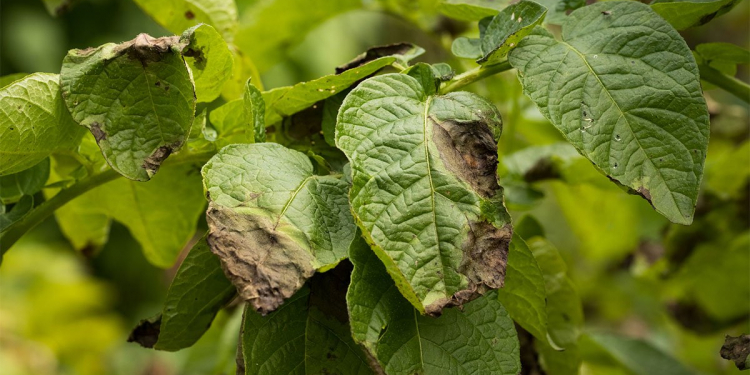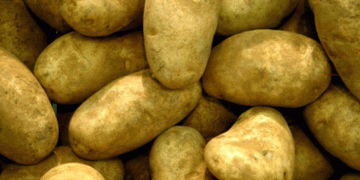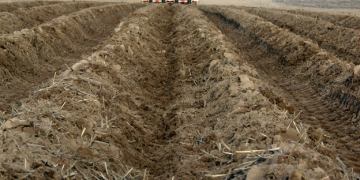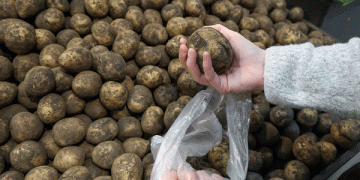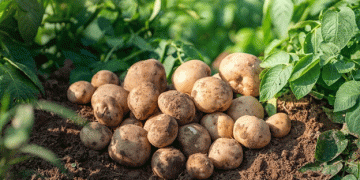Single Phytophthora-resistant potato varieties in particular did not have an easy time this year. The fungal pressure was so high and long this season that the disease was difficult to control. Multiple resistances offer more hope, according to a tour of potato trading houses.

e are shocked at how easily resistant varieties break through. Resistant varieties were even more prone to phytophthora than non-resistant varieties. That is worrying’, says salesman Maarten Kuijsten of Europlant.
‘It should be a wake-up call to evaluate how we deal with this,’ continues Kuijsten. ‘Resistance was suddenly sacred for the robust list of varieties that we use for organic cultivation in the Netherlands. But I think resistance should be sacred and we should protect it.’
Covenant
The seller is referring to the list that was created in 2017 in the context of the covenant ‘ Accelerated introduction to robust potato varieties ‘. An initiative of sector organization Bionext that is supported by all chain parties. This year 36 robust varieties were tested.
“With resistance, greater profit can be made in the conventional sector
MAARTEN KUIJSTEN, SELLER OF EUROPLANT
Otolia is the Europlant variety with a resistance gene. The popular yellow-fleshed ware potato made it through 2021 well, but was eventually hit by phytophthora. Europlant introduces the variety in the organic and conventional segment.
‘Otolia is interesting for conventional growers, because the resistance gene means that the crop needs fewer spraying moments,’ says Kuijsten. In that sector, greater environmental benefits can be achieved with resistance, organic growers are not allowed to use chemicals anyway’, he says.
Two robust table varieties
Den Hartigh includes two robust table varieties on the list. Connect has one resistance gene and is especially strong in the tuber. The late variety made it through the season relatively well, although this variety also showed damage at the end.
‘I am in favor of multiple resistance. Then you keep a variety robust for longer and there is less chance that the resistance will be broken. Nola is doubly resistant and has hardly shown any damage this season’, says head of production Matthijs Kloek.
‘The phytophthora pressure lasted for a long time, about a month and a half’, continues Kloek. ‘Nevertheless, several varieties remained healthy. The importance of robust varieties is increasing. Ban on chemical agents puts extra pressure on breeding. The agreement will be extended this year. I think that’s a positive development.’
Peter Pan
Geersing Potato Specialist will register Peter Pan for the official variety list. The breed is still under research for the robust list. ‘The strongest variety we have’, says director Jan-Eric Geersing. ‘This year he scored a 9.9 on phytophthora. I knew he was good, but no phytophthora at all in such a year is special. Incidentally, that does not mean that the resistance cannot be broken.’
The trading house already has Cammeo, Passion and Tentation on its robust variety list. Cammeo has proven itself in particular thanks to the strong R8 gene and an auxiliary gene. ‘Normally the seed potato sales to Israel start at the end of October, but now we have already supplied potatoes all month,’ says a satisfied director.
Camillo even stronger
A similar variety that the company presents is Camillo, which is even stronger. The variety has the same resistance genes as Cammeo and scored a 9.3 for phytophthora this year. ‘The chances for Camillo are greater, because this breed used to be coarse’, thinks Geersing. ‘The variety does score less well on scab sensitivity and you can’t fry chips with it.’
Plantera’s Vitabella didn’t have it easy this season. ‘Due to the high phytophthora pressure, this variety with its single resistance has died,’ regrets director Jeroen van Soesbergen. ‘The advantage of Vitabella is that it produces large tubers early. The potato can usually be harvested before mid-August and can therefore partially escape from phytophthora.’
The first observations of the other robust variety Cephora are good. It seems to be a robust tuber especially on heavy soil. Cephora scores an 8 on phytophthora in the foliage and a 5.5 on the tuber. The only difference with Vitabella is the cooking type. Cephora has type B, Vitabella cooking type A.
‘Be careful with resistance genes’
‘Be careful with resistance genes,’ says seller Maarten Kuijsten of Europlant. ‘That became clear this year with the breakthroughs. If we use those genes now, we won’t be able to use them later.’ Director Jan-Eric Geersing of Geersing Potato Specialist explains: ‘The door is open for a susceptible variety. As soon as there is phytophthora, the crop is affected. In a resistant variety, the door is closed until Phytophthora has found the key to open it. Isolates that break through the resistance should not be carried over to the following year.’
Plantera director Jeroen van Soesbergen argues in favor of phytophthora monitoring. ‘If you know what type of Phytophthora you have, you can choose a variety that has resistance to it. Then you need to spray less and you benefit more from the resistance genes.’
